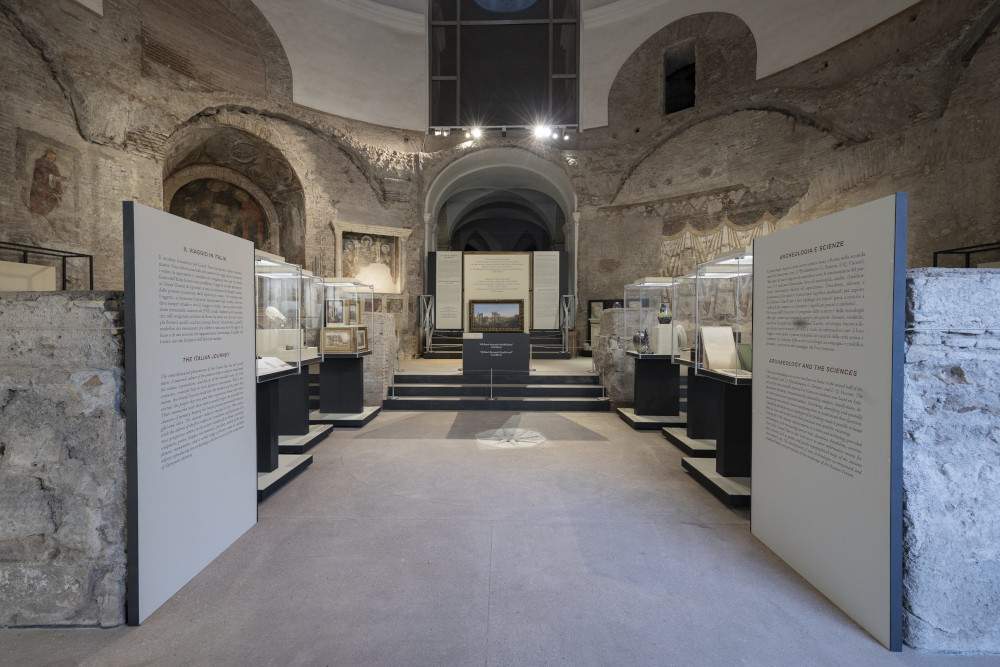A new exhibit at the Temple of Romulus to discover what the Roman Forum area looked like before excavations
From November 21, 2023 to April 28, 2024, the Temple of Romulus presents the new temporary exhibition The Gaze of Time. The Roman Forum in the Modern Age, designed to fill a gap: visitors today see the Roman Forum as it has looked since the years of the Unification of Italy, after a long series of excavations, restorations and accommodations that were carried out throughout the 20th century and are still ongoing today, but few, however, know what theappearance before the season of excavations and more recent arrangements, when the area of the Roman Forum was a semi-rural landscape on the edge of the inhabited city, which nevertheless represented for travelers and scholars from all over Europe the ancient heart of the Urbe and one of the most beloved and celebrated places of international culture.
The new display is thus intended as a historical introduction to the archaeological tour of the Forum. Through a rich series of iconographic testimonies reproduced in copy or digitally, including drawings, prints, paintings, photographs, films, and the display of a small collection of objects-memories related to the material culture of the Grand Tour and the daily and professional life of those who lived and worked in the Forum, such as prints, paintings, models, books, micro-mosaics, fans, scientific instruments, and so on, the exhibition aims to tell the story of the Roman Forum as a landscape between the sixteenth and twentieth centuries, focusing on some significant themes: the rediscovery of Antiquity in the Renaissance, but also the use of the Forum as a quarry of materials for modern Rome; the Forum as an ideal classical landscape and as a rural space (Campo Vaccino); the Grand Tour and the interest of scholars; early scientific studies and plans for the arrangement of the area; and the civic and political use of the space during the age of nationalisms and in contemporary mass civilization.
“The arrangement involved extensive preliminary textual and iconographic research in the endless repertoire of available sources.” As Roberta Alteri, co-curator of the project, explains, “collecting and choosing which themes and aspects to tell about this extraordinary landscape through images and objects was not at all easy. We were faced with an infinite amount of documents, texts, images and studies that risked disorienting us. In choosing, we tried to account for what we thought were the main cultural values expressed over time by this landscape, from the public and international to the more intimate and private. We did not think about the aesthetic or economic value of the works, but about their documentary potential, with a very archaeological selection perspective.” “The installation, which we would like to emphasize is not an exhibition,” added Alessio De Cristofaro, co-curator of the project, “is designed as a visual narrative for all visitors to the Park. Thanks to the simple mechanism of the object-memory and the support of images and short texts, we want to provide some information and suggestions for suggestion and reflection to anyone who wants to approach the history of our monuments, to feel better part of it. Objects, images and videos are designed as a kind of hypertext spread throughout the space set up.”
“The Temple of Romulus is located along the Via Sacra, on the route that thousands of tourists take every day to visit the Roman Forum,” says Alfonsina Russo, director of the Colosseum Archaeological Park, explaining why the new exhibit is housed precisely in the Temple of Romulus. “Its location and extraordinary architectural form seemed to us to be ideal to offer visitors a point of pause and didactic reflection, which would be, at least for those entering from the Arch of Titus, a real vestibule of entry and welcome to the Roman Forum.” “The idea for this new temporary exhibit,” the director concludes, “stems from a desire to enhance and expand our ability to tell visitors about the Park’s many as yet unexpressed cultural values. The Roman Forum was perhaps the most represented and beloved place and landscape in European history, and it is a place that rightfully belongs to all humanity. Telling those who visit it today what it looked like and what its functions were in the centuries of the modern age helps us make the Colosseum Archaeological Park an increasingly shared, participatory and inclusive place of culture.”
The exhibit will be accompanied by a program of guided tours and lectures on some of the themes represented, starting in January 2024.
Photo by Simona Murrone.
 |
| A new exhibit at the Temple of Romulus to discover what the Roman Forum area looked like before excavations |
Warning: the translation into English of the original Italian article was created using automatic tools. We undertake to review all articles, but we do not guarantee the total absence of inaccuracies in the translation due to the program. You can find the original by clicking on the ITA button. If you find any mistake,please contact us.




























